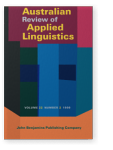Vol. 22:2 (1999) ► pp.119–133
The use of ‘well’ in spoken interaction
An example of what language teachers and learners can get from analysing spoken discourse
In this study the use of "well" as a discourse marker is analysed in sixteen episodes of a television series and in two English language textbooks to illustrate what communicative language teaching can get from work on discourse analysis. Results of the analysis show that the meaning of well as a mainly interactive device signalling acceptance due to modification is present both in television series and in textbooks. However, the analysis also shows an absence of inductive and language awareness approaches to focus learners’ attention on the interactive features of “well” as a discourse marker. Further research is needed in different languages to understand the meaning and use of discourse markers and the implications of these analyses for language teaching.
